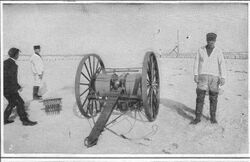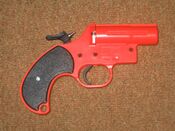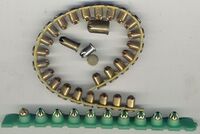Engineering:Firearm (tool)
A firearm is primarily a weapon, but can be used as a tool to project either single or multiple objects at high velocity through a controlled explosion. The firing is achieved by the gases produced through rapid, confined burning of a propellant. This process of rapid burning is technically known as deflagration. In older firearms, this propellant was typically black powder, but modern firearms use smokeless powder, cordite, or other propellants. Many firearms such as mortars do not have rifled bores to impart spin to the projectile for improved flight stability, such as is seen with firearms used as weapons, although some are rifled. The lack of rifling can prevent tangling of grappling hook lines, buoy lines, and such, although some firearms intended for use at the longest ranges in these applications are rifled.
Line throwing
The Manby Mortar was invented by Captain George William Manby, also the inventor of the portable fire extinguisher. On 18 February 1807, Manby looked on helplessly as a Naval ship, the Snipe, ran aground 60 yards off Great Yarmouth during a storm. By some accounts, a total of 214 people drowned, including French prisoners of war, women and children. Following this tragedy, Manby experimented with mortars, and so invented the Manby Mortar, later developed into the breeches buoy, which fired a thin rope from shore into the rigging of a ship in distress. A strong rope, attached to the thin one, could then be pulled aboard the ship. His successful invention followed an experiment as a youth in 1783, when he shot a mortar carrying a line over Downham church. His invention was officially adopted in 1814, and a series of mortar stations were established around the coast.[1] The Manby Mortar was used by the Waterguard and later by H M Coastguard for many years. The first recorded rescue using the Manby mortar was on 18 February 1808; Manby himself was in charge of the mortar and a crew of seven were brought to safety from the Plymouth Brig Elizabeth stranded off the shore at Great Yarmouth.
A Lyle gun was used to shoot a line towards people in distress in order to rescue them and save their lives. The Lyle Gun was toted to the shoreline usually by Surfmen that manned the L.S.S using the tool. The iron wheels that supported the cart had wide bands on the outside the wheel to keep it from sinking into the soft sand especially when it came to being used on the beaches of Cape Cod and other stations along the east coast of North America. The projectile that carried the line to the craft in distress was fired over the ship to ensure its target. The line fired to the ship in distress was one of several designed to support the breeches buoy which would carry survivors back to shore on a line that would take them over the waves.
The Lyle gun could shoot a projectile about 300 yards.
Examples of later firearms based upon the Lyle gun are widely seen in maritime museum displays, such as at the Sleeping Bear Point Coast Guard Station Maritime Museum in Glen Haven, Michigan.[2] The exhibits there focus on the U.S. Life-Saving Service, the U.S. Coast Guard, and Great Lakes shipping history. In the summer, demonstrations are given of rescue drills and equipment used to fire a rescue line from shore more than 400 yards (370 m) to a ship in "distress".
Grappling hook guns
Rifles are also commonly used to launch grappling hooks for various purposes. For example, grappling hooks are currently used by combat engineers breaching tactical obstacles. A grappling hook is launched over the open ground in front of the obstacle and dragged backwards in an attempt to detonate trip-wire-fused land mines, and can be hooked onto wire obstacles and pulled to set off any booby traps on the wire. A tool available for this purpose is the rifle-launched grapnel, a single-use grappling hook placed on the end of an M4/M16 rifle.[3][4] A grapnel can clear up to 99 percent of the trip-wires in a single pass.[5]
Grappling hooks were originally used in naval warfare to catch the rigging of an enemy ship so that it could be drawn in and boarded. Later, grappling hooks were also used in rescue work or to assist in scaling walls. The most common design consists of a central shaft with a hole at the base of the shaft, called an "eye" to attach the rope, and three equally spaced hooks at the end of the shaft, so arranged that at least one is likely to catch on some protuberance of the target. Older designs were almost always firearms, either mortars or cannons, for special use with Lyle guns or similar tools. Some modern designs feature folding hooks to resist unwanted attachment. Modern grappling hooks used in rescue work are propelled by firearms, compressed air, or rockets.
Industrial shotguns
Industrial shotguns have long been used for specialized applications in servicing lime kilns, blast furnaces, and even for making seismic shots. Typically of 8 gauge, industrial shotguns are much larger than most shotguns designed for use as weapons and are designed for firing using fixed mount stations, not being intended for firing from the shoulder. They are used for removing lime deposits from inside kilns and for removing slag deposits from inside blast furnaces, both being used during routine maintenance.[6] The idea is comparable to sandblasting, in that projectiles are forcibly delivered by gas under pressure. When used for generating seismic shots, they provide very repetitive and consistent peak amplitude levels. Industrial shotguns have also been used in lesser sizes (most commonly 10 and 12 gauge) for use in bird control around airports. Both blanks and slugs are used in industrial shotguns, depending on the exact effect desired, blanks most commonly being used for bird control.
Flare guns
Dedicated flare guns exist that fire flares. They are typically used as a distress signal as well as other signaling purposes at sea and between aircraft and people on the ground. The majority of flare guns are 12 gauge, but they should not ever be loaded with live ammunition. The amount of pressure generated by a typical 12 gauge shotgun shell (11,500 psi according to SAAMI) far exceeds the pressure most flare guns can control. Firing shotgun shells from a modern plastic flare gun can have deadly results for the user and should not be done.
The most common type of flare gun is a Very pistol (which can also be spelled Verey pistol), which was named after Edward Wilson Very (1847–1910), an American naval officer who developed and popularized a single-shot breech-loading snub-nosed pistol that fired flares. Modern varieties are frequently made out of brightly colored, durable plastic.
The older type of Very pistol, typical of the type used in the Second World War, are of one inch bore. Newer models fire smaller 12-gauge flares. In countries where possession of firearms is strictly controlled, such as the United Kingdom, the use of Very pistols as emergency equipment on boats is less common than, for example, the United States .
Flare guns may be used whenever someone needs to send a distress signal. The flares must be shot directly above, making the signal visible for a longer period of time and revealing the position of whoever is in need of help.
While not intended as weapons, flare guns can and have been weaponized in some situations. In 1942, at Pembrey Airfield in Wales, a German pilot mistakenly landed at the field. The duty pilot, Sgt. Jeffreys, did not have a conventional weapon; he grabbed a Very pistol and used that to capture the German pilot, Oberleutnant Armin Faber.[7]
Direct fastening systems
Cartridge based concrete anchoring and steel anchoring systems have been devised for firearms used as tools, such as developed by Hilti and Ramset with their so-called powder-actuated tools. Typical calibers range from .22 cal up to 9 mm for the cartridges, which propel anchors and nails into concrete, steel, and other materials. Developed in World War II to temporarily repair ship damage quickly in the case of hull breach, this technology is today commonly used in construction and manufacturing to join materials to hard substrates such as steel and concrete.
In Australia and the Netherlands, these tools are classed as firearms, since they fire a projectile with potentially lethal force. As such, their ownership and use is regulated in Australia and the Netherlands. The owner has to register the tool, and an operator of one of these tools is required to have a license and to have undergone training in their use. These laws are in keeping with Australia's and the Netherlands' strict firearm laws.
From 1958 onwards, the so-called "direct-acting" tools have been quickly replaced by "indirect-acting" tools. In the former type, the combustion gases from a blank powder cartridge directly drive the fastener into the base material. The nail can reach velocities of hundreds of meters per second making it a highly dangerous projectile.
In modern indirect-acting tools, the combustion gas drives a piston inside the tool "barrel" which in turn "hammers" the nail into the material. The piston cannot leave the tool barrel as it is retained by a stop-ring or piston brake. Of the total energy contained in the ensemble of moving piston and nail, ~95% is contained in the piston. Due to a piston mass of ~100...150 g, piston and fastener reach much less than the limit velocity of 100 m/s limited by official approval.
Modern PATs include multiple safety devices: The tool must be pressed to the work surface with >50 N force before it can be triggered. The trigger must be pulled only after full compression or the tool will not work (no "bump-firing" allowed). The tool must pass drop tests in all directions to prove that it will not fire even if dropped on the muzzle or knocked against a hard surface.
European legislation
With the coming into effect of the EC Machinery Directive (2006/42/EC), powder actuated tools are distinguished from weapons and are now considered "impact machinery", provided they are "designed for industrial or technical purposes only".[8] After the testing and approval defined by the Machinery Directive for tools of this type, PAT must carry the CE mark from July, 2011 at the latest (but can since January, 2010). This means that for bringing them to the European market, the manufacturer no longer needs a firearms-type approval from a respective authority but a CE approval from a European accredited test laboratory ("notified body"). Firearms legislation no longer applies to PAT.
A European safety standard (EN 15895) is under development and was expected to be effective at the end of 2010 or beginning of 2011.
See also
- Breeches buoy
- Niagara Scow
References
- ↑ "Obituary in the Gentleman's Magazine". The Gentleman's Magazine (F. Jefferies): 208. January 1855. https://books.google.com/books?id=EO-R3EsTRYYC&pg=PA208&lpg=PA208&dq=%22george+william+manby%22.
- ↑ "Sleeping Bear Dunes National Lakeshore - Maritime Museum". National Park Service. http://www.nps.gov/slbe/planyourvisit/maritimemusem.htm. Retrieved 2008-02-15.
- ↑ The Launch Grapnel Hook (LGH), Infantry Magazine 1999 Sep-Dec pages 4-5
- ↑ United States Army Launched Grapnel Hook (LGH) NSN 1095-01-412-4150, formerly Muzzle Launched Grapnel Hook Projectile US5448937
- ↑ Field Manual 3-34.2 Combined Arms Breaching Operations. 31 August 2000. Para. C-57 and Table C-2
- ↑ Winchester 8 Ga clinker gun
- ↑ Pembrey Airport: History
- ↑ ec.europa.eu
Sources
- Chase, Kenneth (2003). Firearms: A Global History to 1700. Cambridge University Press. ISBN 0-521-82274-2
- Crosby, Alfred W. (2002). Throwing Fire: Projectile Technology Through History. Cambridge University Press. ISBN 0-521-79158-8
- Needham, Joseph (1986). Science & Civilisation in China. V:7: The Gunpowder Epic. Cambridge University Press. ISBN 0-521-30358-3
External links





